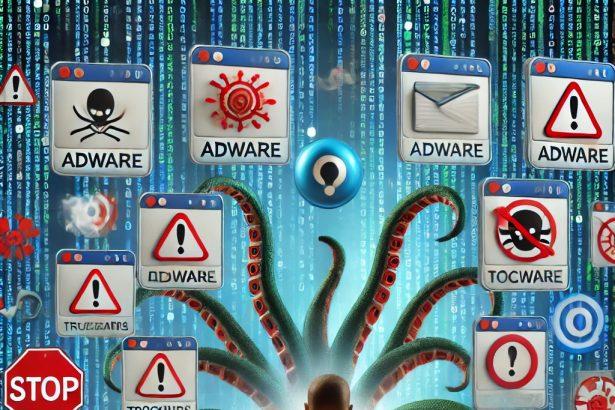Ads by Miredindeed.net isn’t a virus—but it’s deceptive. The malware disguises itself as a download or verification prompt, tricking users into allowing notifications. Once enabled, it delivers intrusive, spammy notifications that persist even when your browser is closed.
Threat Summary
| Threat Type | Push‑notification spam, pop‑up ads |
|---|---|
| Encrypted File Extension | N/A |
| Ransom Note Filename | N/A |
| Email Contact (if any) | N/A |
| Detection Names | Fortinet (Phishing), Google Safe Browsing (Phishing), Seclookup (Malicious), Sophos (Malware) |
| Symptoms | Ads not originating from visited sites, intrusive pop‑ups, slower browsing speed |
| Damage & Distribution | Privacy risk, reduced performance, potential malware or phishing links; distributed via deceptive ads, rogue ad networks, adult/torrent/illegal streaming sites |
| Danger Level | High (due to potential for data theft, phishing, malware exposure) |
| Removal Tool → | SpyHunter |
How Did I Get Infected With Ads by Miredindeed.net?
The malware disguises itself behind fake prompts like “Click Allow to download” or “Press Allow to close this window,” tricking browsers into granting notification permissions. Often, users land on Miredindeed.net via deceptive redirects—malvertising, torrent or streaming sites, compromised webpages, or bundled adware.
What Ads by Miredindeed.net Does to Your System
It pushes spam notifications even after your browser is closed, sending pop‑up ads that often link to fake articles, questionable offers, or phishing forms designed to steal credentials, card info, or install malware or PUPs. Over time, performance may suffer, and your privacy is compromised.
Should You Be Worried About Ads by Miredindeed.net?
Absolutely—while not a virus, the notifications are dangerous. They can lead to financial loss, identity theft, malware infections, or privacy breaches. Denying or revoking notification permissions is critical.
Manual Adware Removal Process (Windows & Mac)
Step 1: Identify and Uninstall Suspicious Applications
For Windows Users
- Open Task Manager by pressing
Ctrl + Shift + Esc. - Navigate to the “Processes” tab and search for unknown or high-resource-consuming processes.
- If you detect anything suspicious, right-click and select “End Task.”
- Go to
Control Panel>Programs>Programs and Features. - Locate and uninstall any unfamiliar programs.
For Mac Users
- Open
Finderand click onApplications. - Identify and move any suspicious applications to the
Trash. - Empty the
Trash. - Check
System Preferences>Users & Groups>Login Itemsfor unknown startup programs and remove them.
Step 2: Remove Malicious Browser Extensions
Google Chrome
- Open Chrome, click
Menu(three dots) >Extensions. - Locate and remove unknown extensions.
- Reset Chrome:
Settings>Reset settings> “Restore settings to their original defaults.”
Mozilla Firefox
- Click
Menu>Add-ons and themes. - Remove suspicious extensions.
- Reset Firefox:
Help>More troubleshooting information> “Refresh Firefox.”
Safari (Mac)
- Open Safari, go to
Preferences>Extensions. - Delete unknown extensions.
- Reset Safari:
History> “Clear History.”
Microsoft Edge
- Click
Menu>Extensions. - Remove any unfamiliar extensions.
- Reset Edge:
Settings>Reset settings> “Restore settings to their default values.”
Step 3: Delete Adware-Associated Files and Folders
For Windows Users
- Press
Win + R, type%AppData%, and press Enter. - Locate and delete suspicious folders.
- Repeat for
%LocalAppData%,%ProgramData%, and%Temp%.
For Mac Users
- Open Finder and press
Shift + Command + G, then enter~/Library/Application Support/. - Remove any suspicious folders.
- Repeat for
~/Library/LaunchAgents/,~/Library/LaunchDaemons/, and~/Library/Preferences/.
Step 4: Flush DNS Cache to Remove Adware Traces
For Windows Users
- Open
Command Promptas Administrator. - Type
ipconfig /flushdnsand press Enter.
For Mac Users
- Open
Terminal. - Enter
sudo killall -HUP mDNSResponderand press Enter.
Step 5: Restart Your System
Perform a reboot to apply the changes and ensure the removal process is complete.
Automatic Adware Removal Using SpyHunter (Windows & Mac)
For an effortless and effective solution, use SpyHunter, a powerful anti-malware tool designed to detect and remove adware completely.
Step 1: Download SpyHunter
Click the link to download SpyHunter: Download SpyHunter Here.
Step 2: Install SpyHunter
Follow the installation guide based on your operating system:
For Windows Users
- Run the downloaded
.exefile. - Follow the installation instructions.
- Launch SpyHunter and allow it to update its malware database.
For Mac Users
- Open the downloaded
.dmgfile. - Drag and drop SpyHunter into
Applications. - Open SpyHunter and let it update its database.
Step 3: Scan and Remove Adware
- Open SpyHunter.
- Click
Start Scan. - Wait for the scan to complete.
- Click
Fix Threatsto remove detected malware.
Step 4: Restart Your Computer
After SpyHunter removes all threats, restart your system to ensure all adware components are fully removed.
Conclusion
Don’t trust “Allow” prompts from unfamiliar websites like Miredindeed.net—most are scams in disguise. Revoke notification permissions in your browser, reset settings, and run a malware scan. Take action now to restore control of your browsing and protect your privacy and security.




